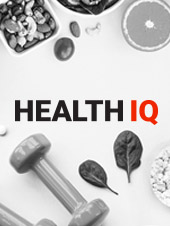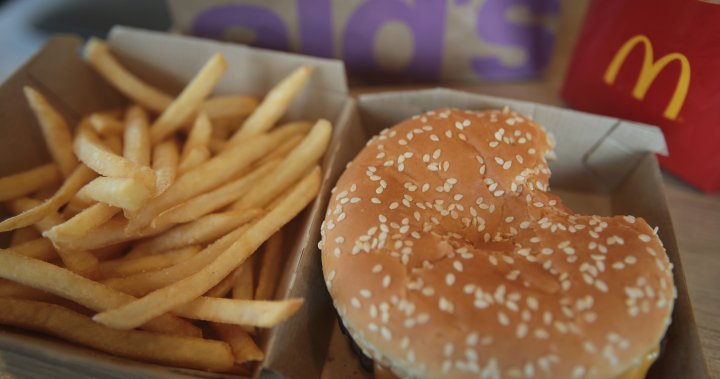A United States E. coli outbreak linked to McDonald’s Quarter Pounders has killed one person and sent 10 people to the hospital, including a child who developed kidney disease.
And as health officials scramble to identify the source of the contamination, many are left wondering if their beloved burgers are safe to eat — including if you’re a consumer in Canada.
While the U.S. Centers for Disease Control and Prevention (CDC) said the overall risk to the public is low now that McDonald’s has pulled Quarter Pounders from restaurants in affected states, E. coli still remains a serious concern, warned Keith Warriner, a food safety professor at the University of Guelph.
“E. coli is a very virulent pathogen with several strains,” he told Global News. “And the worst of the bad E. coli is what we call E. coli O157, and the problem with this pathogen is that it can cause a deadly condition of organ failure, and it is very virulent.”
The E. coli O157:H7 strain, responsible for the McDonald’s outbreak, poses a significant risk to young children, the elderly, and immunocompromised people, Warriner said.

The U.S. Centers for Disease Control and Prevention (CDC) reported the E. coli outbreak late Tuesday, with 49 infections identified between Sept. 27 and Oct. 11 across ten states.
The CDC confirmed that all the affected individuals had eaten Quarter Pounders, resulting in 10 hospitalizations, including a child with complications from hemolytic uremic syndrome (HUS), a kidney-affecting disease. An older individual in Colorado has also died.
White House Press Secretary Karine Jean-Pierre said Wednesday that the Biden administration is monitoring the situation and collaborating with the CDC to identify the source of the outbreak.
Here’s what to know about the E. coli outbreak.
E. coli infections are caused by E. coli bacteria, which can be spread through contact with infected people, animals, or contaminated surfaces, foods, or liquids, according to Health Canada.
It can produce toxins that cause symptoms such as stomach cramps, bloody diarrhea, vomiting, and in severe cases, kidney failure.
The bacteria live naturally in the intestines of some animals and can be found in their feces. These animals include cattle, goats and sheep.
“Where it likes its home is in ruminants, especially cattle,” Warriner said. “And it has special factors that enable it to live in cattle, without causing cattle any illness at all.”
One way E. coli can enter the human food system is through cattle manure runoff. This can contaminate irrigation water and soil, leading to persistent E. coli contamination in crops like lettuce and onions, Warriner explained.

For example, in 2018, there was an E. coli O157:H7 outbreak linked to romaine lettuce from California affecting 51 people in the U.S. and Canada. In cases like this, Warriner said, the lettuce is was probably contaminated from dairy farms and cattle feedlots located near the growing areas.

Get weekly health news
Receive the latest medical news and health information delivered to you every Sunday.
And because we don’t cook the greens, it can be one of the riskiest options when it comes to food safety. Cooking destroys bacteria, whereas salads are often simply rinsed and served. And rinsing does not get rid of E. coli, he warned.
Beef can also be contaminated with E. coli during slaughter. Cattle can get manure on their hides and transfer the bacteria to the carcass, which can survive processing treatments like acid washes, Warriner said.
“Then we ground the meat up, it gets incorporated into the ground meat, and then when goes when it goes into patties, it goes to the actual food service restaurant,” he added.
An example of this is the E. coli O157:H7 strain linked to a 1993 incident at Jack in the Box in the U.S., which resulted in the deaths of four children.

What part of the burger was affected?
The initial findings from the investigation indicate that a subset of illnesses may be linked to slivered onions used in the Quarter Pounder, McDonald’s said in a Tuesday statement.
“We have taken steps to proactively remove slivered onions, which are used on Quarter Pounders in restaurants in select states. We have also made the decision to remove the Quarter Pounder from restaurants in select states,” McDonald’s U.S. president Joe Erlinger said in a Tuesday video statement.
“It is important to note that the majority of menu items are not affected. Other beef products at McDonald’s including the cheeseburger, hamburger, Big Mac, McDouble, and the Double Cheeseburger are not impacted.”
Initially, the beef patty was considered a possible source of contamination. However, Warriner noted that McDonald’s has very strict food safety protocols in place for its meat, so he would be surprised if that were the source.

“In the case of McDonald’s, they have some of the safest food safety systems out there. Their food safety training is second to none in the industry. So I’m pretty sure they were not to due to the burger, but with the onions, and that’s a totally different story,” Warriner said.
This occurs because flooding events near cattle can allow bacteria to infiltrate the onions themselves. While washing removes bacteria from the surface, it does not eliminate them from the inside.
“Washing onions does not work,” he said. “And because we eat them raw, the end result is what we’re seeing now.”
Warriner suggested that the hydroxyl radical process, a highly effective method for reducing bacterial contamination, should be adopted by more food suppliers, including McDonald’s. This method can thoroughly clean both the interior and exterior of produce, using hydroxyl radicals to penetrate and eliminate contaminants.
However, he noted this process is still very rarely used by food suppliers.
How did it spread to different McDonald’s?
Initial findings suggested a subset of the illnesses were linked to onions sourced from a single supplier that serves three distribution centers, McDonald’s stated.
The infections have spread across Colorado, Iowa, Kansas, Missouri, Montana, Nebraska, Oregon, Utah, Wisconsin, and Wyoming. Colorado reported the most cases, with 26, followed by Nebraska with nine.
Erlinger said it’s possible the contaminated product has already worked its way through McDonald’s supply chain. But the company will work closely with the government and cooperate with the investigation, he said. Erlinger declined to name the supplier or say if it supplies other restaurant chains or grocery stores.
Everyone interviewed in connection with the outbreak had reported eating at McDonald’s before falling ill and most mentioned eating Quarter Pounder hamburgers, the CDC said.
Given the widespread nature of the E. coli outbreak, Warriner suggested the source of contamination is likely a supplier rather than an individual McDonald’s restaurant.
“But the reality is that McDonald’s sent auditors to look at the supplier. But the problem is we have auditors that say, ‘Yeah, looks all right’, but they don’t really know,” Warriner said.
“Going back to the fact that they rely on this washing process to remove field-acquired contamination, when they know it doesn’t work.”

Should Canadians be worried?
Global News emailed Health Canada on Tuesday asking the health regulator whether the McDonald’s E. coli outbreak impacted Canadians.
A Health Canada spokesperson referred Global News to its online listing of active outbreak investigations, which does not include any mention of E. coli infections at McDonald’s restaurants in Canada.
In an email to Global News on Tuesday, a McDonald’s Canada spokesperson said, “We want to reassure our Canadian guests that the situation affecting some McDonald’s restaurants in certain U.S. states does not impact our Canadian restaurants, or menu items.”
“Across the McDonald’s System, serving customers safely in every single restaurant, each and every day, is our top priority and something we’ll never compromise on,” the spokesperson said.
Warriner noted that it’s unlikely the contamination has spread into Canada’s food supply. However, if you’re concerned and planning to visit McDonald’s, it may put your mind at ease to order a hamburger without onions for now.
— with files from Reuters





